1. Introduction
 After
the DW1640 released several months ago, BenQ expands its optical storage range
with yet another release, an upgrade to the DW1625, the DW1655. A quick look
at the drive's specifications, will reveal that the main upgrades from the previous
release are 16X for DVD -R up from 8X, 8X up from 4X for +RW, 6X from 4X for
-RW, 8X from 2.4X for DVD +R DL, while now also supporting DVD -R DL at 4X.
After
the DW1640 released several months ago, BenQ expands its optical storage range
with yet another release, an upgrade to the DW1625, the DW1655. A quick look
at the drive's specifications, will reveal that the main upgrades from the previous
release are 16X for DVD -R up from 8X, 8X up from 4X for +RW, 6X from 4X for
-RW, 8X from 2.4X for DVD +R DL, while now also supporting DVD -R DL at 4X.
Apart from this, there are also writing quality improvements which we'll be
having a look at. All tests have been updated since the preview of the drive
presented recently so we will be going through our usual array of tests, including
writing quality and error correction in the course of this review but we'll
begin with a quick look at the drive's main features...
- Features
Here is a list of the drive's main features as found on the official BenQ optical
storage web site.
 Lightscribe Technology
Lightscribe Technology
BenQ has launched its DW1655 DVD ReWriter with LightScribe Direct Disc Labeling Technology, to dress them up. LightScribe Technology will enable you to easily create customized, silkscreen-quality labels directly on CDs and DVDs using their own PCs through a combination of LightScribe-compatible media, recordable optical drives and special software. Burn, Flip, Burn
 Solid Burn
Solid Burn
The BenQ DW1655 is Solid Burn embedded, meaning that it automatically learns to optimize writing quality, therefore ensuring maximum compatibility.
 Write Right Technologies
Write Right Technologies
BenQ's exclusive Write Right Technology utilizes two powerful features: Tilt Control and WOPC II (Walking Optimal Power Control II). By using these features the DW1655 is able to maintain perfect control over both the laser beam angel and the power rate being projected onto the disc, ensuring every bit of your data is written at the best possibly quality.
- Specifications
| Model |
BenQ DW1655 |
| Write Speed |
16X +R |
| 16X -R |
| 8X +RW |
| 6X -RW |
| 8X +R DL |
| 4X -R DL |
| 48X CD-R |
| 32X CDRW |
| Read Speed |
DVD-ROM 16X |
| CD-ROM 48X |
| Seek Times |
120ms (DVD) |
| 120ms (CD) |
| Technical Specifications |
| Interface |
ATA / ATAPI |
| Data buffer |
2 MB |
| Writing Mode |
DVD+R/+RW
DVD Data and Video |
CD-R/-RW
Track-at-Once, Disc-at-Once, Multisession, Packet Writing (fixed & variable packet), CD Digital Audio, Direct-Over-Write on CD-RW, Simulation Writing |
| Disc Formats |
DVD |
Write: DVD+R DL 8.5GB, DVD-R DL 8.5GB, DVD+R 4.7GB , DVD+RW 4.7GB , DVD-R 4.7GB ,DVD-RW 4.7GB (Close session) |
| Read: DVD-5, DVD-9, DVD-10, DVD-18, DVD+R/-R/+RW/-RW |
| CD |
CD-DA, CD-ROM XA (m1, m2f1/m2f2), CD-R, CD-RW, Bootable CD, Photo CD (single & multi-session), Video CD, Super Video CD, CD-Extra, Mixed-mode CD, CD-Text, CD-Graphics |
| Lightscribe |
CD-R, DVD+R, DVD-R |
| OS Compatibility |
Windows XP / 2000 / ME / 98SE |
| Power Requirement |
DC 5V +/- 5%, ripple 160mVpp
DC12V+/- 10%, ripple 180mVpp |
| Environment Conditions |
Operating temperature: 5°C~50°C (41°F~122°F)
Operating humidity: 8%~80% RH
Non-operating temperature: -40°C~60°C (-40°F~140°F)
Non-operating humidity: 5%~95% RH |
| Reliability characteristics |
MTBF: 125.000 POH (20%)
Non-recoverable read error < 1 block in 1012 bits (CD and DVD) |
| System Requirement |
IBM PC compatible Pentium III 550MHz CPU or above
128MB DRAM, 100MB free HDD space for CD/DVD recording related software installation. 1GB free HDD space for CD Image recording |

Below are the main specs for the drive, as given by NeroInfoTool and DVDInfoPro and VSO Inspector.
- Nero InfoTool
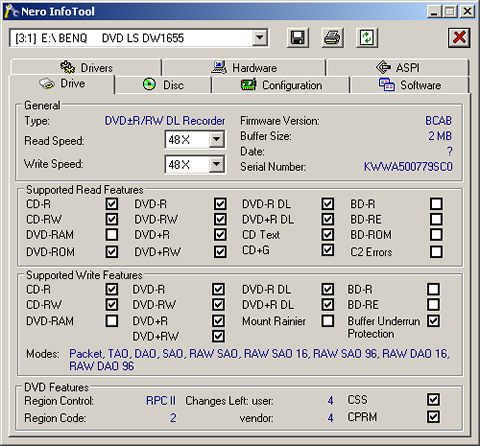
- DVD InfoPro
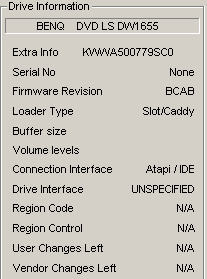

- VSO Inspector
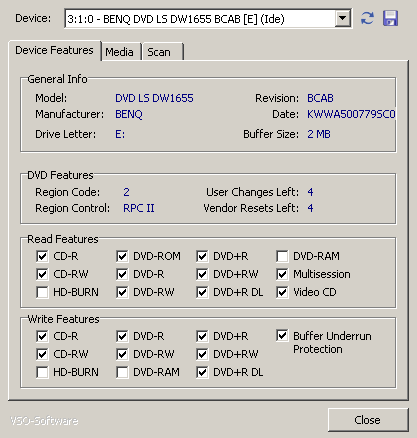
- The Drive
We received the bulk version, accompanied with a DVD Re-Writer Software Disc (Ver.2.4 which is also included in the bundled version), containing several applications such as the Nero Suite, QSuite v2.1, Lightscribe v1.4.44.1, Quick start guide and Acrobat Reader. For more information about the bundled version of the drive, you can look it up on the official BenQ website, here.
- Front panel view

- Rear panel view

- Label

Removing the cover renders the drive's warranty void. You can have a closer
look at the drive itself, as well as inspect the chipset used in the DW1655,
by clicking on the image below, which will produce a larger, more detailed view
of the inside of the drive.
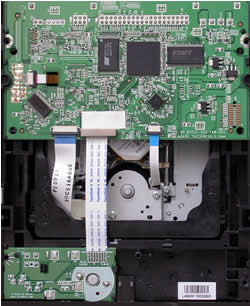
The chipset used is once again made by Philips (as in the BenQ DW1640 drive), but this time is the PNX7862EL, seen
in the picture below.

- Installation
We installed the drive under WinXP as a master and it was identified as "BENQ
DVD LS DW1655". From Nero's advanced options dialogue, we can
disable the buffer under-run protection as well as the DVD high compatibility
mode. The drive came with the latest firmware installed.
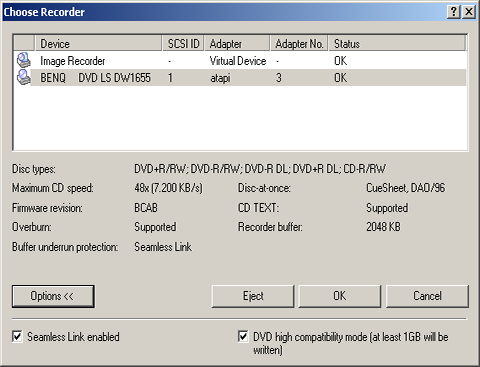
As it has become customary to do with the latest release review drives, we
will be comparing the drive's performance with that of two other latest drives,
the Plextor PX 755A and the LiteOn 1635S.
So let's move on to the rest of this review of the BenQ 1655, starting with
the DVD reading capabilities.
2. Reading Tests
- CD Format
 For
our CD transfer rate tests, we used the Nero CD-Speed utility and two different
media, one Pressed and one USRW. Let's take a look at how the drive performed
compared with the other two drives.
For
our CD transfer rate tests, we used the Nero CD-Speed utility and two different
media, one Pressed and one USRW. Let's take a look at how the drive performed
compared with the other two drives.

The BenQ drive supports up to 48X reading speed with Pressed CD media and
so was close to the performance of the LiteOn drive which is known for its reading
capabilities.
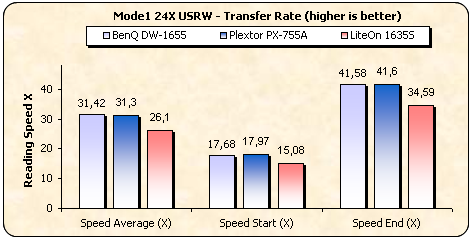
Once more, fast reading speeds from the BenQ drive, this time with USRW CD
media.
- AudioCD
For this tests we used a pressed AudioCD, as well as the Advanced DAE test through the use of Nero CD-DVD Speed.
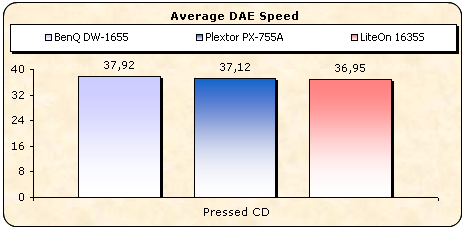

The BenQ DW-1655 media supports a relatively high DAE speed. As the Advanced
DAE quality test reported, the Quality score was a perfect 100, while the reported
average speed was 33.15X. The drive supports CD Text, Subchannel Date reading
as well as Leadin, but not Leadout data.

- 90mins Audio disc
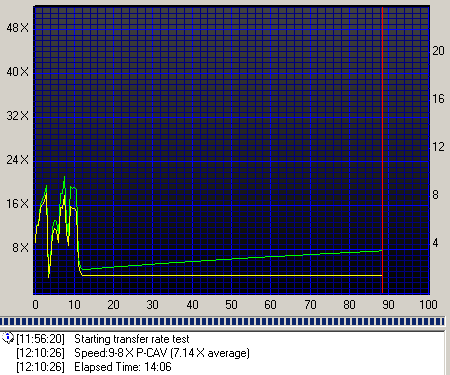
- 90mins Audio disc
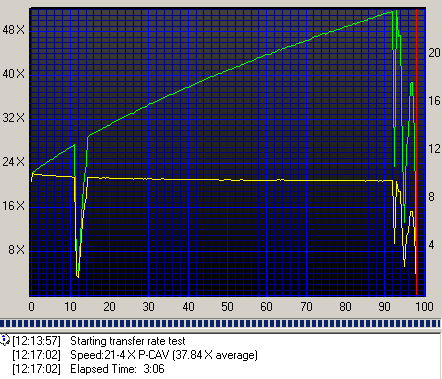
The drive managed to finish reading both the 90 and 99 mins audio media. As
we can see from the above screen-shots, the 90 mins audio CD was read at around
7X average speed and the 99mins audio CD although reaching the maximum reading
speed, could not continue at this speed all the way to the end, where the drive
had some erratic speed changes but was nonetheless successful in reading the
disc.
- DVD Format
 Let's have a look at how the drive performs with DVD media. A set of DVD media was used, both SL and DL.
Let's have a look at how the drive performs with DVD media. A set of DVD media was used, both SL and DL.

Since all three drives support up to 16X max reading speed with SL media, all drives reported almost identical speeds.
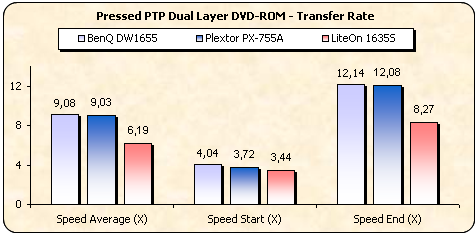
The two layers of a PTP DVD-ROM disc are read sequentially with
the drive starting reading from the inner part of the disc, which is the beginning
of each layer, progressing towards its outer range. When reading PTP media,
the BenQ and Plextor drives reported the highest speeds, with the LiteOn being
slowest, due to its 8X max reading speed with DL media.
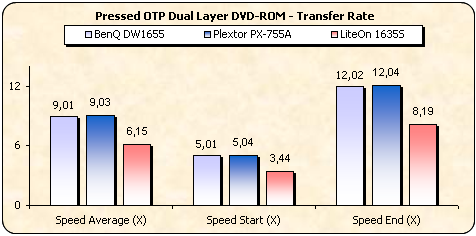
The first layer of an OTP dual layer DVD-ROM is read exactly
the same way as the first layer of the PTP disc we tested previously, the main
difference being the reading strategy of the second layer on the disc. The beginning
of the second layer is located in the outer part of the disc, so the drive starts
reading from the outer tracks towards the inner part of the disc. Again, the
BenQ and Plextor drives were faster with almost identical speeds. There's very
little between the BenQ and Plextor drives with the various DVD-ROM formats.


With write once media, the reviewed drive dominates, reporting the highest
average speeds of 12.09X and 12.05X for DVD+R and DVD-R media respectively,
due to its supported speed of 16X for these formats. With re-writable media,
the BenQ drive was again fastest although speed differences between the reviewed
drive and the other two are negligible.

Good ripping speed was reported, with an average of 12559kb/s, placing it just behind the Plextor drive.
-Appendix
Nero CD-DVD Speed Graphs
CD Pressed / US-RW / AudioCD /
DVD Pressed SL / DVD Pressed DL PTP / DVD Pressed DL OTP / DVD-R / DVD-RW / DVD+R / DVD+RW
3. CD Error Correction
In the following tests, we check the drive's behavior when reading scratched
/ defective audio discs. The test discs used were the ABEX series from ALMEDIO.
- ABEX TCD-721R


|
Errors
total
|
Num:
1224102
|
|
Errors
(Loudness) dB(A)
|
Num: 59435 |
Avg:
-73.3 dB(A) |
Max:
-32.0 dB(A) |
|
Error
Muting Samples
|
Num: 3823 |
Avg:
1.0 Samples |
Max: 25 Samples |
|
Skips
Samples
|
Num: 0 |
Avg:
0.0 Samples |
Max:
0 Samples |
Total Test Result |
76.4 points (out of 100.0 maximum) |
The total error count is about average, perhaps bordering on the high side
but the loudness level is quite good with a maximum at -32dB(A). Muting samples
are low and most important of all, no skipped samples. The total test result
score of 76.4 is very good.
- ABEX TCD-726


Errors total |
Num: 2036 |
Errors (Loudness) dB(A) |
Num: 3018 |
Avg:-174.0 dB(A) |
Max:-174.0 dB(A) |
Error Muting Samples |
Num: 0 |
Avg: 0 Samples |
Max: 0 Samples |
Skips Samples |
Num: 0 |
Avg: 0 Samples |
Max: 0 Samples |
Total Test Result |
100.0 points (out of 100.0 maximum) |
Results with the 726 test disc are great, with flawless reading and a perfect
total test result score of 100.
- CD-Check Audio Test Disc
 The CD-Check Test Disc is a very useful tool for evaluating the Sound Reproduction
/ Error correction capabilities of a CD player. The disc offers a signal combination
with disc error patterns to rate the drive's abilities to read music and reproduce
it completely. Five tracks on the disc contain a sequence of progressively
more difficult tests. These tracks are referred to as Check Level-1 through
Check Level-5.
The CD-Check Test Disc is a very useful tool for evaluating the Sound Reproduction
/ Error correction capabilities of a CD player. The disc offers a signal combination
with disc error patterns to rate the drive's abilities to read music and reproduce
it completely. Five tracks on the disc contain a sequence of progressively
more difficult tests. These tracks are referred to as Check Level-1 through
Check Level-5.
The
tracks are reproduced through a software multimedia player (i.e.
Windows Media Player). Each level is considered as passed, if the tone
is smooth, continuous without interruptions, skipping or looping. The higher
the Check Level passed, the more reliable the sound reproduction
of the tested drive.
|
Error Level
|
1
|
2
|
3
|
4
|
5
|
|
|
5/5
|
5/5
|
5/5
|
5/5
|
5/5
|
With this test disc, the drive produced excellent performance, achieving flawless
reading in 5 out of 5 tracks. It has been a long time since a drive has been
able to read all 5 tracks.
- Summary
The CD error correction capabilities of the DW1655 are extremely good.
4. DVD Error Correction
In the following tests, we check the DVD reading capabilities of the BenQ DW1655 drive with scratched / defective DVD media. For our tests, we used CDVD Benchmark and Nero CDSpeed. The reference test media comes from ALMEDIO.
- Single Layer media
ABEX TDR-821
This is a single sided, single layer DVD-ROM with a 4.7GB capacity, and its surface has an artificial scratch varying in dimensions from 0.4 to 3.0 mm.

The following transfer rate picture comes from the CDVD Benchmark v1.21 transfer rate test.

The reading speed maxed out at just above 8X, which is a little slow. Also notice that at the beginning, the speed ranged between 6X and 3.5X before eventually beginning the reading process.
ABEX TDR-825
This is also a single sided, single layer DVD-ROM of 4.7GB capacity. The data structure of the disc is exactly the same as that of the TDR-821, the only difference being that there are no scratches on it. Instead, there are defective areas, ranging in dimensions from 0.5 to 1.1 mm.

There are also fingerprints sized between 65 and 75 micrometers.

In this case, the drive read all the way to the end of the test
without any errors, while after the second defective area, the reading speed
maxed out at 14X, with minor jumps down to 6.5X.
- Dual Layer media
ABEX TDR-841
This is an 8.5GB dual layer single sided DVD-ROM disc with artificial scratches ranging dimensionally from 0.4 to 3.0mm, on both layers.


Both layers were read flawlessly, reaching a max speed of 12X, while a small
speed drop was noticed over the last part of the defects region on both layers.
ABEX TDR-845
The disc is a single sided, dual layer DVD-ROM disc of a 8.5GBcapacity. The only difference between the TDR-845 and the TDR-841 is that the former includes defective areas and fingerprints.

The dimensions of the defective areas range from 0.5 to 1.1 mm and the fingerprints are sized from 65 to 75 micro meters.

The drive successfully completed reading both layers, passing over all four artificially defective areas, without any drops in speed or errors being reported.
ABEX TDV-541
The TDV-541 is a single sided, dual layer DVD-VIDEO disc, with a capacity
of 8.5GB. The disc is based on the TDV-540 series which was designed to inspect and adjust DVD-VIDEO players. The disc checks the layer switch operation
from layer 0 to layer 1 and also includes test pictures and test signals on
DVD sound files.

The current TDV-541 also checks the error correcting capabilities of
the drive. It also includes scratches from 0.4 to 3.0 mm.

Even though the drive managed to complete its reading of the 541 test media,
the reading was not stable all the way to the end with a few problems during
the last stage of the first layer and just after the layer switch.
ABEX TDV-545
The TDV-545 disc is based on the TDV-540 series. It is a single sided, dual layer DVD-VIDEO disc with a capacity of 8.5GB. The TDV-545 includes artificial black dots on the data surface, sized from 0.4 to 1.0 mm. It has also 65 - 75 micro meter fingerprints.


With the 545 test disc, the drive did not present any problems, successfully reading all the way to the end of the test.
- Summary
Even though the DVD error correction tests reported no errors whatsoever,
the performance of the drive was not excellent, as one can clearly see from
the drops or deviations in speed during most of the tests. None the less, the
drive will read over defective areas, even though this may be to lower reading
speeds.
5. Protected Discs
At this point, we will check the drive's ability to read and backup protected
CDs.
- AudioCD protections
 For
the test procedure, we used three audio discs with different audio copy protection
schemes. The ripping process for all protected Audio discs was carried out with
Exact Audio Copy v0.9 beta5.
For
the test procedure, we used three audio discs with different audio copy protection
schemes. The ripping process for all protected Audio discs was carried out with
Exact Audio Copy v0.9 beta5.
The protected Audio discs tested, were:
| Audio Discs |
Protection |
| Celine Dion - New Day Has Come |
Sony's Key2Audio |
| Natalie Imbruglia - White Lilies Island |
Cactus Data Shield 200 |
| Aiko Katsukino - The Love Letter |
Cactus Data Shield 200.0.4 - 3.0 build 16a |
The Cactus Data Shield 200, contains artificial errors that are not easily bypassed by the reader, while the Key2Audio contains a second session causing problems to readers when trying to read the Table Of Contents (TOC).
The tested tasks are:
- Recognition of the inserted disc (Yes/No).
- Ripping all wav files(with EAC's Burst Mode) to the hard disk through copy&compare function.
- Listening to the produced wav files to detect any possible click/skips.
The drive recognized up to the 12th Audio track in the CDS200 disc,

and with the "Retrieve Native TOC" option removed, the drive recognized the 13th track.

The test results are shown in the following table:
| BenQ DW1655 |
Key2Audio |
CDS200 |
| Ripping process completed, EAC reports no problems, Read&Test CRC comparison successful for all tracks |
Ripping process completed, EAC reports no problems, Read&Test CRC comparison successful for all tracks |
The drive ripped both discs successfully.
- Cactus Data Shield 200.0.4 - 3.0 build 16a (Aiko Katsukino - The Love Letter)
This is a "special" CDS200 build, since it doesn't contain any artificial errors which create problems during the ripping process. Most problems occur when trying to write the ripped wav files, since the produced CD-R disc contains C2 and CU errors! This "problem" is rumored to be connected to specific chipset weaknesses.
| BenQ DW1655 |
CDS 200.0.4 - 3.0 build 16a |
| Reading performed without any errors. |
- Games Protections
 To
create the image of the various protected titles onto the hard disk, we used
Alcohol 120% software and the appropriate settings, in accordance with the protection
type of the inserted discs. Below you can see the duration of each process as
well as the transfer rate in each case.
To
create the image of the various protected titles onto the hard disk, we used
Alcohol 120% software and the appropriate settings, in accordance with the protection
type of the inserted discs. Below you can see the duration of each process as
well as the transfer rate in each case.

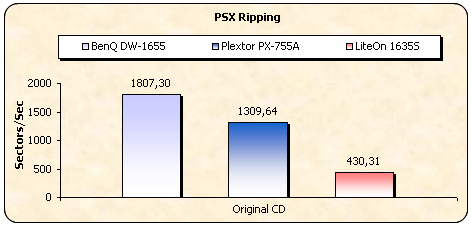
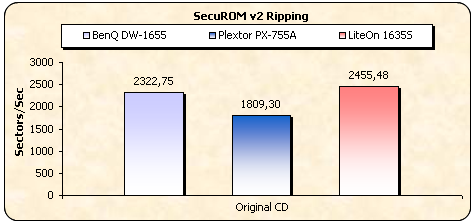
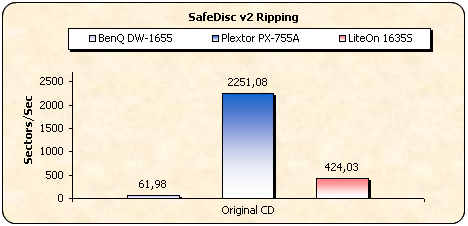
PSX and Securom ripping are not a problem for the BenQ drive. This is however
is not the case with Safedisc protection, which seems to be a privilege of the
Plextor burner.
- Writing Tests
The BenQ DW-1655 supports the DAO-RAW writing mode. To check the drive's
EFM correction status we used 5 different game titles with different SafeDisc
2 versions, having the latest software patches installed. After making the images
of the various titles onto the hard disk, we burned them (at maximum speed) with
Alcohol 120% v1.9.2.3105. Two different discs were recorded for each title;
one with the "Rectify Sub-Channel Data" enabled and one with the function
disabled.
- Fifa 2004 - Safe Disc v3.1x
- The Sims Superstar - Safe Disc v2.9x
None of the above games worked when copied with the DW1655.
6. CD Writing Tests
-
CD-R Format
The drive supports 8X, 16X, 24X, 32X, 40X and 48X (CAV) writing speeds.
According to Nero CDSpeed, the reported average speed when recording at 48X
is 36.43X.

- CD-R Recording Times
We created an 80min data compilation with Nero Burning Rom and recorded it
on a 700MB disc. The writing times vary only slightly depending to the inserted
media. Below is a chart depicting all recording times with various media brands.

Best burn (speed wise) came with Verbatim CD media, burned in 3:00 at a max
speed of 48X. The difference however is negligible.
- Other features

The drive supports CD Over-burning up to 99mins.
- CD-RW Format
The BenQ DW-1655 supports 4X, 10X, 16X (CLV), 24X (Z-CLV) and 32X (P-CAV) rewriting speeds,
with Ultra Speed Rewritable Media
(US-RW).
Below you can see the Nero CD-DVD Speed writing simulation test with blank 32x US-RW media.

The drive, when recording at 32X, reported an average writing speed of 30.80X.
7. CD Writing Quality - Plextools
 We
measured the C1 / C2 error rate on the recorded discs we burned at the various
supported writing speeds. The software we used is the latest PleXTools Professional
and specifically, the built-in Q-Check utility. The Plextor PX-716A was the
reader.
We
measured the C1 / C2 error rate on the recorded discs we burned at the various
supported writing speeds. The software we used is the latest PleXTools Professional
and specifically, the built-in Q-Check utility. The Plextor PX-716A was the
reader.
BenQ 80min 52X @ 48X
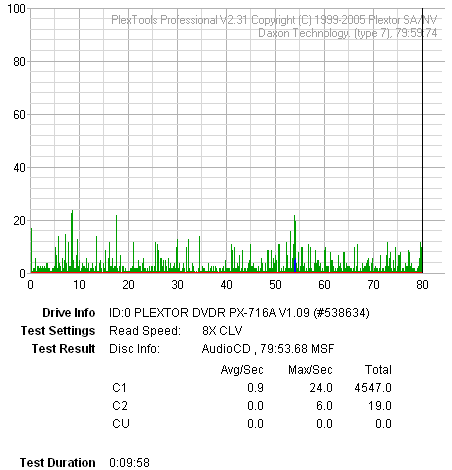
Mmore 80min 52X @ 48X
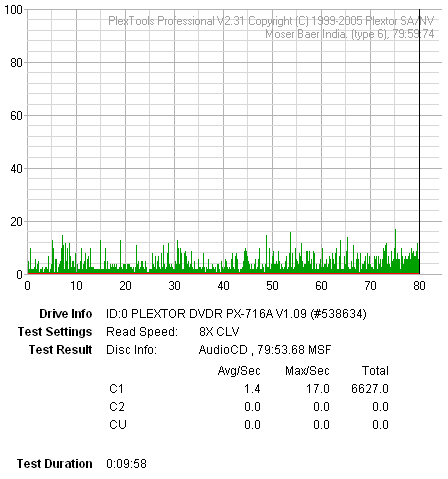
SKC 80min 52X @ 48X

Traxdata 80min 52X @ 48X

Verbatim 80min 52X @ 48X

- Summary
According to Plextools Professional, the drive managed to produce some good
burns. Three out of five media scanned, reported Low C1 values and no C2. Worst
burn came with Traxdata media, where the C2 values were quite high.
8. CD Writing Quality - Clover System
The Clover System CDX Compact Disc Analyzer is a high-speed tool to quantitatively measure the quality of a CD. It will analyze CD-DA, CD-ROM, CD-ROM XA, CD-I, CD-R, Photo-CD, Enhanced CD and CD-RW discs at 4X, 8X, 24X, 32X or 40X speeds. It effectively measures disc quality by examining the quantity and severity of CIRC errors generated during playback. It also provides the capability to measure signal parameters related to pit geometry, such as asymmetry and reflectivity. When put together, all these facts provide a thorough analysis of disc quality. The Clover System Analyzers can also perform various format-checking tests on data discs, and do bit-for-bit data comparison on all types of CDs. All tests are carried out at a maximum speed of 40X.
CIRC error correction uses two principles to detect and correct errors. The first is redundancy (extra information is added, which gives an extra chance to read the disc), and the second is interleaving (data is distributed over a relatively large physical area). The CIRC error correction used in CD players uses two stages of error correction, the well known C1 and C2, with de-interleaving of the data between the stages.
The error type E11 means one bad symbol was corrected in the C1 stage. E21means two bad symbols were corrected in the C1 stage. E31 means that there were three or more bad symbols at the C1 stage. This block is uncorrectable at the C1 stage, and is passed to the C2 stage. Respectively, E12 means one bad symbol was corrected in the C2 stage and E22 means two bad symbols were corrected in the C2 stage. E32 means that there were three or more bad symbols in one block at the C2 stage, and therefore this error is not correctable.
BLER (Block Error Rate) is defined as the number of data blocks per second that contain detectable errors, at the input of the C1 decoder. Since this is the most general measurement of the quality of a disc, you will find BLER graphs for all media tested below. If you click on the images you can see a more detailed table, indicating error levels. The Red Book specification (IEC 908) calls for a maximum BLER of 220 per second averaged over ten seconds. Discs with higher BLER are likely to produce uncorrectable errors. Al low BLER shows that the system as a whole is performing well, and the pit geometry is good. However, BLER only tells us how many errors were generated per second, and it does not tell us anything about the severity of those errors.
BenQ 80min 52X @ 48X
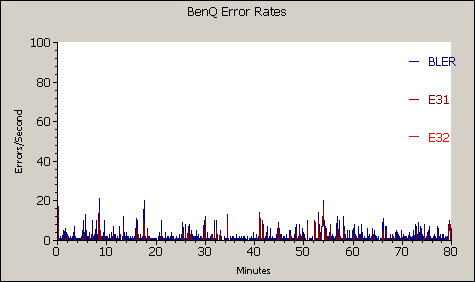
MMore 80min 52X @ 48X
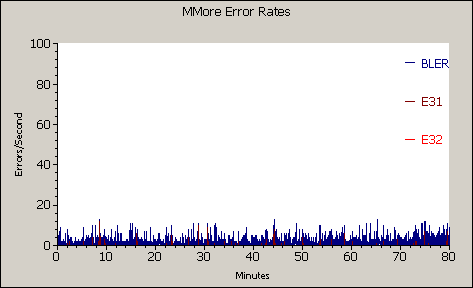
SKC 80min 52X @ 48X
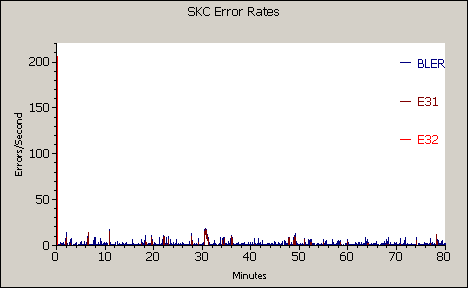
Traxdata 80min 52X @ 48X

Verbatim 80min 52X @ 48X
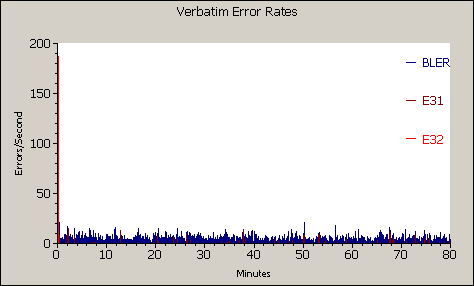
- Summary
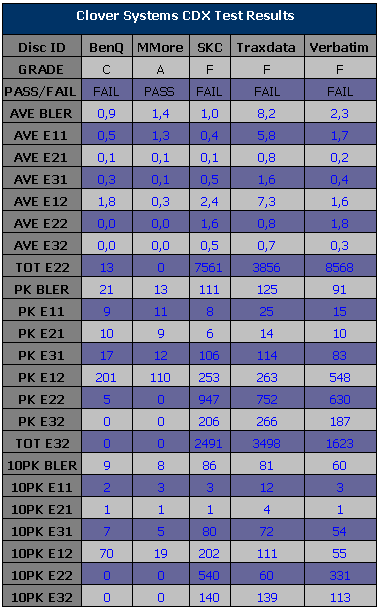
The drive managed to burn MMore and BenQ media at good quality, while the other
three brands produced an E32 spike at the beginning of the recording and received
an F grading. This is possibly due to a bug, in which case, keeping in mind
the Plextools results, we consider that the quality is acceptable. There are
many cases in the past where Clover Systems' results were different from Plextools
but in this case, the graphs are also totally different.
9. DVD Writing Tests
- Writing Performance
Now we will check the burning performance with DVD media. Below, the available writing speed list as reported by Nero Burning Rom can be seen.

Using Nero CDSpeed with DVD-R and DVD+R media, we are able to see
the 16X writing strategies.
- DVD+R media @ 16X CAV

- DVD-R media @ 16X CAV
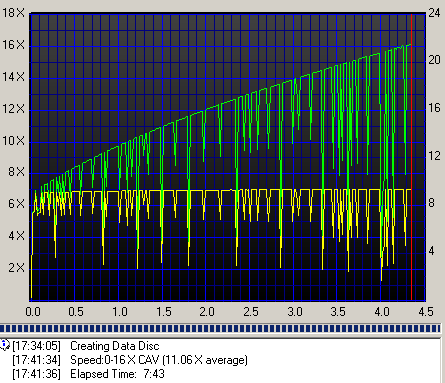
- Burning Tests
We used a variety of 16X and 8X certified media to test the burning capabilities of the DW1655 DVD recorder.
DVD-R media

With the Overspeed option disabled through the QSuite utility, the drive burned
almost all media at their certified speeds, although some drops were reported,
with Optodisc 16X media burned at 12X and with Optodisc 8X media which reported
a final burning time equal to that of a 2X burn. This is due to the SolidBurn
feature.

Here is a list of various burned 16X effective media and the reported times...

Same performance here, with Optodisc media burned at 12X. The Philips media
was burned at 16X reporting an overall time equal to an 8X burn. All other media
were burned at their certified speeds. At 8X burning speed, the drive did quite
well, although BenQ media was burned at an equivalent speed of 2X requiring
24:56 mins.

- DVD Overburning Test
DVD+R

DVD-R

The DW1655 supports overburning with ±R media, even at 16X, adding 500MB
space to standard DVD media (in the case of the -R media).
10. DVD Writing Quality - Page 1
In order to test the writing quality and readability of the burned media, we
used two readers equipped with two software applications:
- The LiteON SOHD-167T with patched firmware being able to read DVD5 up to
16X CAV and DVD9 up to 10X CAV. For the transfer rate tests we used
the
latest Nero CDSpeed version.
- The Plextor PX-716A with the latest available firmware. For scanning the
disc, we used the latest PlexTools version at 2X CLV reading speed,
BURST mode, with middle accuracy.
In general, a "perfect" disc should have a smooth reading curve,
very low PIE/POE and zero (0) POF error rates. Most times however, even though
a disc has very low PIE/POE error rates, the reading curve may not be smooth
containing
dropoffs.
Due to the fact that we oversped the reading capabilities of the LiteON SOHD-167T,
such drops are expected, especially near the outer area of the disc.
The measurements below should not be taken as the absolute criterion of the
burning quality, but as an indication only.
16X DVD+R Writing Speed
- BenQ 16X DVD+R @ 16X


- Optodisc 16X DVD+R @ 12X


- Philips 16X DVD+R @ 16X


- Plextor 16X DVD+R @ 16X


- Prodisc(R05) 16X DVD+R @ 16X
+R_16X.png)
+R_16X.png)
- Prodisc(R04) 16X DVD+R @ 16X
+R_16X.png)
+R_16X.png)
- Ricoh 16X DVD+R @ 16X


- Ridisc 16X DVD+R @ 16X


- Traxdata 16X DVD+R @ 16X


- Verbatim 16X DVD+R @ 16X


- Summary
According to Plextools and CD-Speed, the reported burning quality
can be described as good. Some media, such as Optodisc and Traxdata, reported
high PI levels while most media produced drops in speed with the CD-Speed scans.
11. DVD Writing Quality - Page 2
In order to test the writing quality and readability of the burned media we
used two readers equipped with two software applications:
- The LiteON SOHD-167T with patched firmware being able to read DVD5 up to
16X CAV and DVD9 up to 10X CAV. For the transfer rate tests we used the latest
Nero CDSpeed version.
- The Plextor PX-716A with the latest available firmware. For scanning the
disc, we used the latest PlexTools version at 2X CLV reading speed, BURST
mode, with middle accuracy.
In general, a "perfect" disc should have a smooth reading curve,
very low PIE/POE and zero (0) POF error rates. Most times however, even though
a disc has very low PIE/POE error rates, the reading curve may not be smooth
containing dropoffs. Due to the fact that we oversped the reading capabilities
of the LiteON SOHD-167T, such drops are expected, especially near the outer
area of the disc.
The measurements below should not be taken as the absolute criterion of the
burning quality, but as an indication only.
8X DVD+R Writing Speed
- BeAll 8X DVD+R @ 8X


- BenQ 8X DVD+R @ 8X


- CMC Magnetics 8X DVD+R @ 8X


- Maxell 8X DVD+R @ 8X


- MKM 8X DVD+R @ 8X


- Optodisc 8X DVD+R @ 8X


- Ricoh 8X DVD+R @ 8X


- TDK 8X DVD+R @ 8X


- Traxdata 8X DVD+R @ 8X


- TY 8X DVD+R @ 8X


- Summary
At 8X burning speed, the drive performed very well, with smooth CD-Speed graphs
in the majority and low PI values, within the acceptable limits. Best burn came
with the TY media, which as one can see from the above graph, reported very
low PI values and no PO whatsoever. Overall, excellent writing quality at 8X.
12. DVD Writing Quality - Page 3
In order to test the writing quality and readability of the burned media, we
used two readers equipped with two software applications:
- The LiteON SOHD-167T with patched firmware being able to read DVD5 up to
16X CAV and DVD9 up to 10X CAV. For the transfer rate tests we used the latest
Nero CDSpeed version.
- The Plextor PX-716A with the latest available firmware. For scanning the
disc, we used the latest PlexTools version at 2X CLV reading speed, BURST
mode, with middle accuracy.
In general, a "perfect" disc should have a smooth reading curve,
very low PIE/POE and zero (0) POF error rates. Most times however, even though
a disc has very low PIE/POE error rates, the reading curve may not be smooth
containing dropoffs. Due to the fact that we oversped the reading capabilities
of the LiteON SOHD-167T, such drops are expected, especially near the outer
area of the disc.
The measurements below should not be taken as the absolute criterion of the
burning quality, but as an indication only.
16X DVD-R Writing Speed
- BenQ 16X DVD-R @ 16X
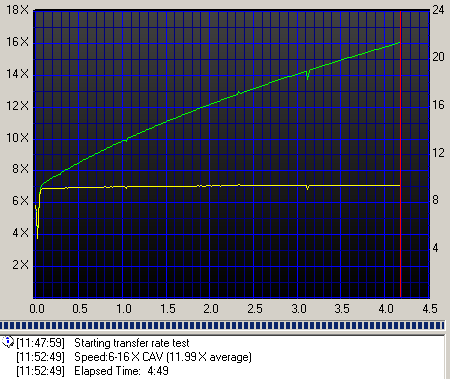

- Optodisc 16X DVD-R @ 12X


- Philips 16X DVD-R @ 16X
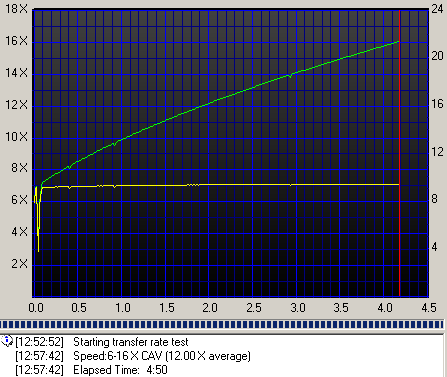

- Prodisc(S05) 16X DVD-R @ 16X
-R_16X.png)
-R_16X.png)
- Prodisc(F02) 16X DVD-R @ 16X
-R_16X.png)
-R_16X.png)
- Traxdata 16X DVD-R @ 16X


- Verbatim 16X DVD-R @ 16X
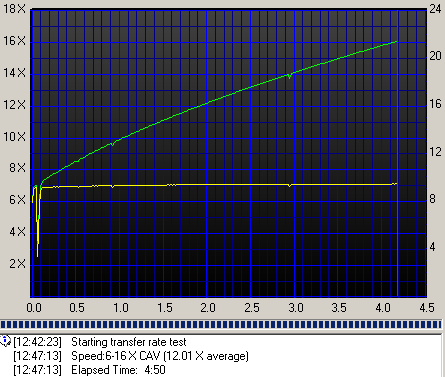

- Summary
Same performance with DVD+R media at 16X burning speed. In this case, Prodisc media (S05) did not complete the Plextools quality scan, due to high error values, where the media was rendered unreadable. Overall, average to good quality burns at 16X effective speed.
13. DVD Writing Quality - Page 4
In order to test the writing quality and readability of the burned media we
used two readers equipped with two software applications:
- The LiteON SOHD-167T with patched firmware being able to read DVD5 up to
16X CAV and DVD9 up to 10X CAV. For the transfer rate tests we used the latest
Nero CDSpeed version.
- The Plextor PX-716A with the latest available firmware. For scanning the
disc, we used the latest PlexTools version at 2X CLV reading speed, BURST
mode, with middle accuracy.
In general, a "perfect" disc should have a smooth reading curve,
very low PIE/POE and zero (0) POF error rates. Most times however, even though
a disc has very low PIE/POE error rates, the reading curve may not be smooth
containing dropoffs. Due to the fact that we oversped the reading capabilities
of the LiteON SOHD-167T, such drops are expected, especially near the outer
area of the disc.
The measurements below should not be taken as the absolute criterion of the
burning quality, but as an indication only.
8X DVD-R Writing Speed
- BenQ 8X DVD-R @ 8X


- Bulkpaq 8X DVD-R @ 8X


- CMC 8X DVD-R @ 8X
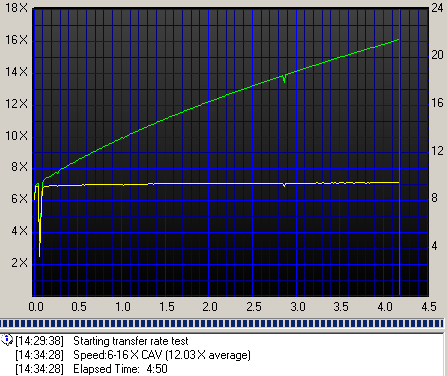

- Datawrite 8X DVD-R @ 8X
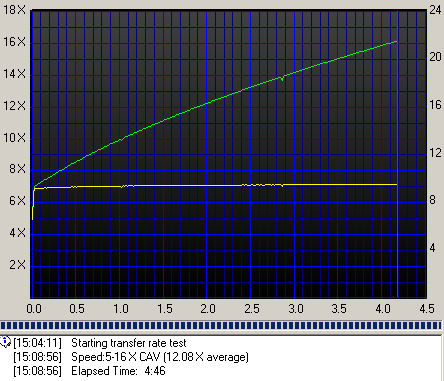

- Maxell 8X DVD-R @ 8X


- MKM 8X DVD-R @ 8X

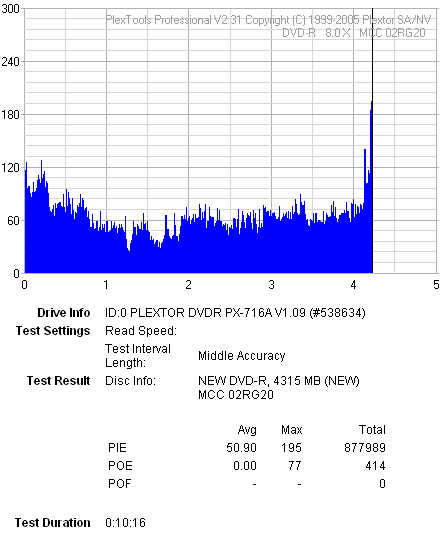
- Optodisc 8X DVD-R @ 8X


- Ridisc Red 8X DVD-R @ 8X
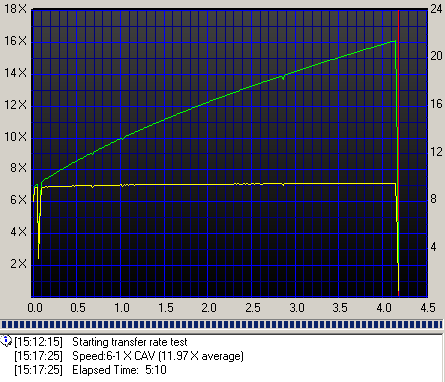

- TDK 8X DVD-R @ 8X


- Traxdata 8X DVD-R @ 8X
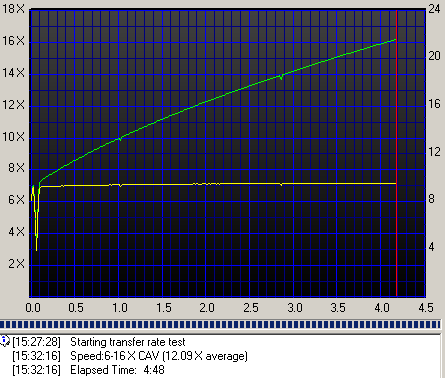

- TY 8X DVD-R @ 8X

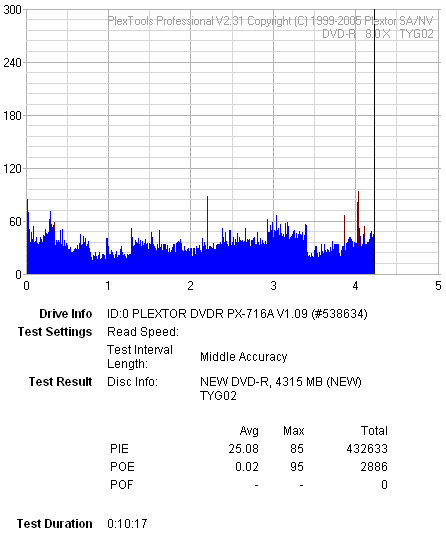
- Summary
Same performance as with 8X +R media. The drive managed to achieve some good
burns, with relatively low values. Ridisc -R 8X media reported a fatal error
during the quality tests, and Optodisc media will probably produce problems
in the near future judging by the high PIE count and levels.
14. DVD Writing Quality - Page 5
In order to test the writing quality and readability of the burned media we
used two readers equipped with two software applications:
- The LiteON SOHD-167T with patched firmware being able to read DVD5 up to
16X CAV and DVD9 up to 10X CAV. For the transfer rate tests we used the latest
Nero CDSpeed version.
- The Plextor PX-712A with the latest available firmware. For scanning the
disc, we used the latest PlexTools version at 2X CLV reading speed, BURST
mode, with middle accuracy.
In general, a "perfect" disc should have a smooth reading curve,
very low PIE/POE and zero (0) POF error rates. Most times however, even though
a disc has very low PIE/POE error rates, the reading curve may not be smooth
containing dropoffs. Due to the fact that we oversped the reading capabilities
of the LiteON SOHD-167T, such drops are expected, especially near the outer
area of the disc.
The measurements below should not be taken as the absolute criterion of the
burning quality, but as an indication only.
DVD+RW and DVD-RW Media
- MKM 8X DVD+RW @ 8X


- MKM 6X DVD-RW @ 6X

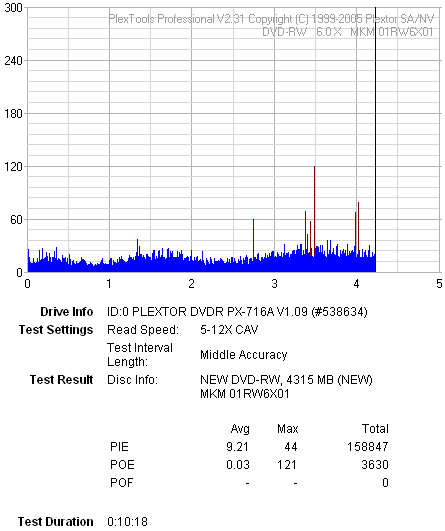
- Traxdata 6X DVD-RW @ 6X

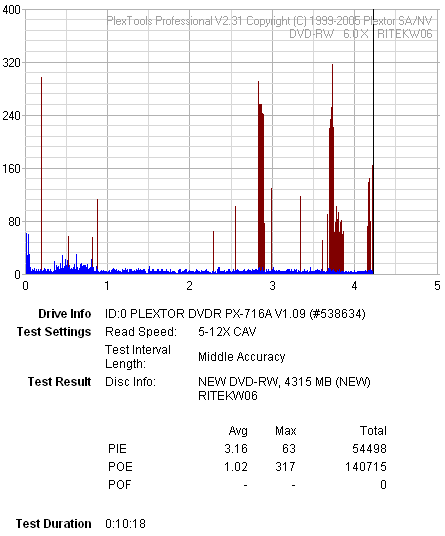
- Summary
All Re-Writable media were burned at their specified speed while both Q-Check
utilities reported relatively good results.
15. DVD Writing Quality - Almedio
The AEC-1000 consists of a DVD Drive and the "ALChecker" error measurement application which can check the written data quality. The application is capable of 1X CLV measurement as well as 4X CLV on DVD-Video/ROM and finalized DVD+R/-R media.
There are three measurement modes:
- Fine Mode: checks a series of eight consecutive ECC blocks,
- Rough Mode: checks eight consecutive ECC blocks every 100h ECC blocks
- Quick Mode: checks three specified areas
The checking status is shown graphically in real time while you can save the error graph at the end of the test. The reported errors are the PI and the UncPO. The PI counts the number of rows corrected by the PI error correction in each group of eight consecutive ECC blocks. The UncPO counts the number of ECC blocks in which more than one bytes are uncorrectable in eight consecutive ECC blocks. For our quality scans, we set for 1X CLV and Fine Mode which is the slowest and produces the safest results. Also, we chose to measure all the media burned at the maximum available writing speed, namely 16X.
- BenQ 16X DVD-R @ 16X
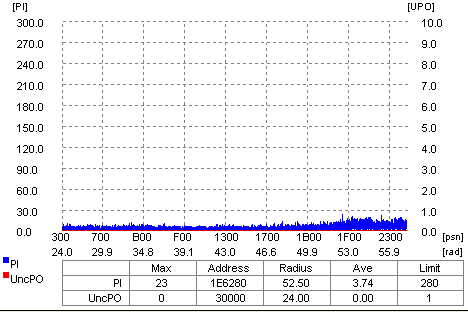
- Prodisc(F02) 16X DVD-R @ 16X
-R_16X_G.png)
- Verbatim 16X DVD-R @ 16X
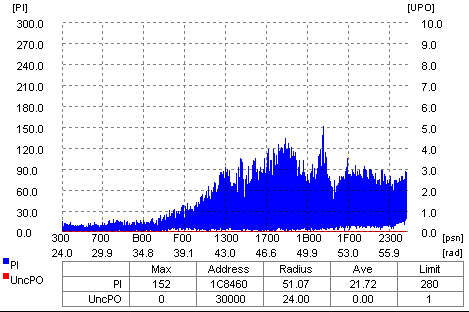
- Philips 16X DVD+R @ 16X

- Prodisc(Ro05) 16X DVD+R @ 16X
+R_16X.png)
- Verbatim 16X DVD+R @ 16X

- Summary
According to Almedio AEC-1000 error checker, all media tested were of good
quality. Good to see that burned media quality is improving with every new release,
when we compare these graphs to those from previous drives.
16. DVDR DL - Page 1
- Writing Tests
We burned some DVD+R DL and DVD-R DL discs with data content. For this task we used "Create Data Disc" from Nero CDSpeed in order to fully burn the discs.
Mitsubishi Chemicals DVD+R DL 8X @ 6X

As seen in the above graph, the drive managed to successfully write MKM +R DL media at 6X burning speed in 22:00mins. The max supported burning speed with +R DL media is 8X, but the drive failed to respond, even though the MKM disc is 8X certified. Notice the WOPC writing strategy, a characteristic widely used in BenQ drives.
Traxdata DVD+R DL 8X @ 8X

Using P-CAV, the drive managed to complete the test in 21:08mins, with a max speed of 8X and an average of 6.63X. WOPC is active here too, while there was a noticeable drop in speed towards the end of the first layer.
Mitsubishi Chemicals DVD-R DL 4X @ 4X

The maximum supported speed for -R DL media is 4X. As seen in the above graph
with MKM 4X certified media, the burn time 32:48mins, reporting an average speed
of 3.52X.
17. DVDR DL - Page 2
- Writing Quality
In order to test the writing quality and readability of the burned media, we used two readers equipped with two software applications:
- The LiteON SOHD-167T with patched firmware being able to read DVD5 up to 16X CAV and DVD9 up to 10X CAV. For the transfer rate tests we used the latest Nero CDSpeed version.
- The Plextor PX-716A with the latest available firmware. For scanning the disc, we used the latest PlexTools version at 2X CLV reading speed, BURST mode, with middle accuracy.
In general, a "perfect" disc should have a smooth reading curve, very low PIE/POE and zero (0) POF error rates. Most times however, even though a disc has very low PIE/POE error rates, the reading curve may not be smooth containing dropoffs. Due to the fact that we oversped the reading capabilities of the LiteON SOHD-167T, such drops are expected, especially near the outer area of the disc.
The measurements below should not be taken as the absolute criterion of the
burning quality, but as an indication only.
- Verbatim DVD+R DL 8X @ 6X


According to both the CD Speed and Plextools quality check utilities, the reported
quality with MKM +RDL 8X media is very good, with very low PI and PO counts
while PO levels are within the acceptable limit.
- Traxdata DVD+R DL 8X @ 8X


Once more, good quality burn at 8X burn speed this time. Note here that some
PO values according to PlextoolsPro are above the 280 limit, which may cause
problems in the near future...
- MKM DVD-R DL 4X @ 4X

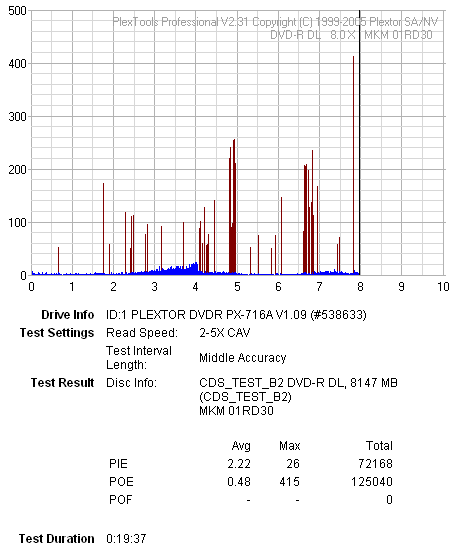
Average to good quality burn. Unfortunate about the POE spike at the end.
Overall, good quality burns, even though in a couple of cases POE values overshot the 280 limit.
18. DW1655 vs SA300 - Page 1
For checking exactly what
the BenQ DW1655 reports, we used three different media, burned with other
recorders. The three media have been measured with the well known AudioDev
SA300 DVD
CATS system at 1X.
The drive is capable of reporting PI/PIF errors, so we will compare those
measurements at 8X reading speed.
Please note that the posted results are only valid for the specific tested BenQ DW1655 drive. Using other drives, even another DW1655, can produce totally different
results. Be aware!
#1st Test Disc - PISum8/PIF Comparison - 8X Reading speed



From the above graphs, we can see that the error line trend follows the same
pattern as the original CATS scans.
19. DW1655 vs SA300 - Page 2
For checking exactly what the BenQ DW1655 reports, we used three different media, burned with other recorders. The three media have been measured with the well known AudioDev SA300 DVD CATS system at 1X.
The drive is capable of reporting PI/PIF errors, so we will compare those measurements at 8X reading speed.
Please note that the posted results are only valid for the specific tested BenQ DW-1655 drive. Using other drives, even another DW1655, can produce totally different results. Be aware!
#2nd Test Disc - PISum8/PIF Comparison - 4X Reading speed



In this case, the graph pattern is almost similar to that of the CATS error line pattern.
20. DW1655 vs SA300 - Page 3
For checking exactly what the BenQ DW1655 reports, we used three different media, burned with other recorders. The three media have been measured with the well known AudioDev SA300 DVD CATS system at 1X.
The drive is capable of reporting PI/PIF errors, so we will compare those measurements at 8X reading speed.
Please note that the posted results are only valid for the specific tested BenQ DW1655 drive. Using other drives, even another DW1655, can produce totally different results. Be aware!
#3rd Test Disc - PISum8/PIF Comparison - 4X Reading speed



The trend line reported follows the CATS trend line.
21. DW1655 vs SA300 - Page 4
For checking exactly what the BenQ DW1655 reports, we used three different
media, burned with other recorders. The three media have been measured
using the well known AudioDev SA300 DVD CATS system at 1X.
The drive is capable of reporting PI/PIF errors, so we will compare those measurements at 8X reading speed.
Please note that the posted results are only valid for the specific tested BenQ DW1655 drive. Using other drives, even another DW1655, can produce totally different
results. Be aware!
#4th Test Disc - PISum8/PIF Comparison - 4X Reading speed



And lastly, a somewhat close trend line to the original CATS.
22. Booktype Support
The booktype setting enables a drive to change the booktype of media (+R, +RW,
+RDL only) prior to burning, in order to maximize its compatibility with stand
alone players. This is one of the advanced features that most of the current
market drives have as a standard. This procedure differs from drive to drive.
With the BenQ drive, the Booktype setting change can be achieved with the accompanying
Q-Suite utility, which among other things, enables the user to set the booktype
of media.
The procedure is simple and does not need to be repeated every time, as the changes made with the Q-Suite utility are stored and used as defaults with every burn the user makes.
1. After installing the Q-Suite software, we ran it and chose the Book Type tab.

2. The first window (see above) provides possible changes we can make to the
drive. By default, as one can see here, the DVD+R and DVD+R DL media will be
changed to DVD-ROM after the burn has commenced. If you choose to change booktype
for DVD+R media for example, (by pressing the "Set to DVD+R Type"), you get
the following message.

As is clearly stated in the warning message, changes will apply to NEW media
only, and further booktype modification is not possible once the media is burned.
3. If we press OK, the next time we write a DVD+R media, the Booktype will be set to DVD+R.

A very useful and easy to use feature, available with the Q-Suite utility.
23. QSuite Utility

The
QSuite utility is a management tool for BenQ drives, which can be used to enable
or disable certain features, as well as run a Quality test or even simulate
a burning. Let's have a look at the software's functions and analyse each one
separately.
1. Information Tab
Under the Information tab, the user will find valuable info about their drive
(in our case the DW-1655) such as Firmware Version and Region Setting, as well
as any currently inserted media.

2. BookType Tab
As explained in the previous page, through the Booktype controls of the QSuite
utility, the user can set the desired Booktype setting for each of the three
eligible types of media (+R, +RW, +R DL), as well as collecting information
on the current booktype of the inserted media.

3. QScan Tab
With the aid of this QScan feature, the user can test various blank media in
order to achieve best results pertaining to media max speed and best quality
burn.

4. WOPC Tab
The well known writing strategy used in BenQ drives can be disabled through
the WOPC tab, even though BenQ informs that the results are not guaranteed (burned
quality).

5. Test Write Tab
Through the Test write tab, the user can enable writing simulation with any burning software used (only for +R,+RW,+R DL).

6. Solid Burn Tab
Solid Burn can be adjusted to suit the end user's needs. In addition to that,
the user can clean the learned disc pool (for the un-known media inserted).

7. Overspeed Tab
Overspeed is by default disabled, although the user can enable this function
to achieve even higher writing speeds. Once again, quality may be affected through
the use of this option.

24. LightScribe Feature
 The
Lightscribe technology is widely used with all latest drive releases. As with
the BenQ 1625, the DW-1655 also supports the LightScribe feature, enabling the
end user to customize the external appearance of his burned media. As we've
seen from previous drive reviews, the use of the LightScribe drives is quite
easy and almost similar from one to the next. Having said that, lets have a
look at what is LightScribe and how it works...
The
Lightscribe technology is widely used with all latest drive releases. As with
the BenQ 1625, the DW-1655 also supports the LightScribe feature, enabling the
end user to customize the external appearance of his burned media. As we've
seen from previous drive reviews, the use of the LightScribe drives is quite
easy and almost similar from one to the next. Having said that, lets have a
look at what is LightScribe and how it works...
-What is LightScribe?
The LightScribe technology, is an integrated system that with the combination
of three key elements, manages to produce "precise" as it is said,
CD and DVD labels. These three elements are the Lightscribe enabled drive, the
specially dye coated discs, and the specific supported software. Note that the
use of specific coated media is required and cannot be done with ordinary printable
media.
-How it works?
In layman's terms, the LS enabled drive, uses a laser that emits light energy
onto the thin dye coated disc (the label side of the media) changing chemically
the dye coating, that activates visible points on the disc. As the disc spins
inside the drive, the light beam marks specific points on the dye, following
the pattern given to the drives mechanism, by the LightScribe software mentioned
before. This results in a precision image on the label side of the disc.
- DW-1655 LightScribe Drive
 The LightScribe feature can be characterised as quite easy in use, carried out
through a simple wizard menu that is inter grated into the latest Nero releases,
as well as in the bundled NERO OEM suite included in the retail package.
The LightScribe feature can be characterised as quite easy in use, carried out
through a simple wizard menu that is inter grated into the latest Nero releases,
as well as in the bundled NERO OEM suite included in the retail package.
As soon as we press the LightScribe button, located on the top right of the
Nero Burning ROM main screen, the wizard prompts us to indicate the image which
we want to "print" on the media. We can scale the image, use fonts,
etc., common tools available with all labeling software. Then we choose the
preferred print quality (print time is dependent on the quality level, which
ranges from draft to best) and we are ready to start.
An alternate option is to use Nero Smart Start, where the wizard guides you
to the desired outcome.
Note here that in order to print on LS enabled media, we must put it in the
tray upside down. This may seem a bit strange, but that's the way it must be
done.

Last step, we start printing on the media. The Printing process highly depends
on quality and differs from drive to drive.
The LS writing test was completed in approx. 27mins.
The result is shown below, and we can see all logos clearly printed on the
LS effective media as well as light to dark gradations...

25. Firmware upgrade - BCDB
Right before the release of the BenQ DW1655 Full Review by CDRinfo, BenQ released
a firmware upgrade from BCAB to BCDB. The firmware notes are not available yet,
since it has been provided to us straight from the tech department and is not
yet under public distribution.
We patched our review drive with the latest firmware and we repeated some of
the burnings that did not report good quality writings. Hence, we will be posting
the results of the BCDB firmware and DW-1655 in this page with three media :
Prodisc S05 -R 16X, Optodisc -R 8X and Ridisc -R 8X media.
We also repeated the reading of the 541 test disc but we didn't notice any difference.
Quality Scans
Optodisc-R 8X @ 8X


Ridisc-R 8X @ 8X


Prodisc(S05)-R 16X @ 16X


Even though the quality of the Optodisc and Ridisc media was greatly improved,
the Optodisc media still retains its high error values, reporting PI higher
than the 280 acceptable limit. Ridisc media was readable with the Plextools
Pro Q-Check utility. The quality of the Prodisc media was also improved, with
error values close to the 280 limit.
26. Conclusion

The
BenQ DW1655 is the latest drive released after the 1640. It is an upgrade of
the 1625, released some months ago, which also featured the LS technology. We
put the 1625 under the scope and found it to be a good drive, with a quite a
few merits but also a few flaws. Let's sum up.
Even though CD media is not as widely used as it was in the past, it is always
good to see a device with good CD support which can achieve good speeds, an
area where some of the latest models fail. The DW1655 supports up to 48X reading
speed with pressed media and up to 32X for HSRW media. As a DVD reading device,
the drive performed admirably, reading pressed SL media with a speed up to 16X
and DL media up to 12X. Write once media were read at a max speed of 16X and
Re-Writable media at a max speed of 12X. Due to the high reading CD/DVD speeds
and the ability to read everything we tried without a single error, we have
awarded the drive five stars (for reading) in our ratings table at the end of
this page.

In the Error Correction arena, results are excellent. Both the 721 and 726
test CD media produced very good scores, but it was the CD-Check test disc where
we were pleased to see that the drive managed to achieve a flawless reading
of 5/5 tracks.
With Protected games, the DW1655 managed to rip all inserted media, although
Safedisc media was ripped extremely slowly, taking an hour and a half to complete.
All audio protected media were ripped and played back successfully.
CD writing quality could be improved, since the drive produced some C2 errors
with Plextools and E22, E32 with some media in the Clover Systems test. At 48X
however, the drive is a good CD burner. DVD writing quality was very good, if
not perfect, in many cases, with all media burned at their certified speeds,
and the reported quality according to CD-Speed and Plextools Pro Q-ckeck utilities
was good. With a few media, the drive reported average writing quality, some
was even unreadable, (e.g. Ridisc -R 8X). However, the latest firmware revision
from BenQ, which was released during our tests, corrected this. With DVD R DL
as well as DVD RW media, the drive produced very good burns also.
The LightScribe mechanism of the drive performed satisfactorily, with a full
print in normal mode accomplished in 26mins. The accompanying bundled software
CD contains the Nero OEM suite, covers all LS needs the user might have with
the click of only a few buttons.
A great PLUS for the drive, is the Q-Suite utility. An experienced end user
will find the tool quite useful, while a novice user will be able to master
all of its features in a short time.
Overall, a very good drive, with all the basic features and the LightScribe
feature for the most demanding users. The price, at the time of the review,
was at US$63 from newegg.com.
- The Good
- Fast DVD ripper
- DVD Writing quality with most media
- Performance with CD-Check Audio Test Disc
- LightScribe enabled drive
- Can overburn CD media up to 99mins
- Can perform Quality Checks
- Q-Suite utility is an advantage
- Supports overburning with both DVD+R and DVD-R media
- The Bad
- Performance with 541 test media
- Cannot create working backups of games with recent SafeDisc protection versions
- Like To be fixed
- Writing quality with specific media can be better

| Reading |
 |
| Error Correction |
 |
| Protected Discs |
 |
| Writing |
 |
| Features |
 |